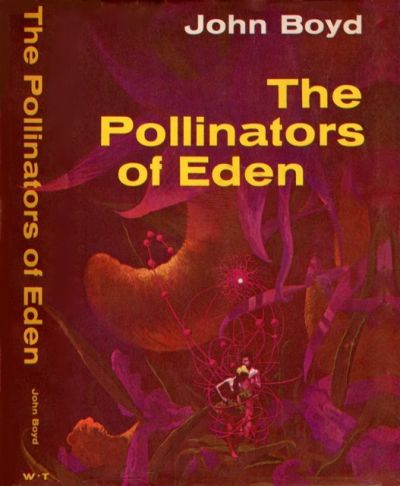The One Where She Has Sex With a Plant
The Pollinators of Eden
By John Boyd

14 Jul, 2019
John Boyd’s 1969 The Pollinators of Eden is a standalone SF novel.
Doctor Freda Caron expects that when the starship Botany docks, her fiancé Paul Theaston will be on it. He isn’t; all she gets is a message and a sample of alien life. Paul is doing research on the planet Flora, where he has encountered an intriguing scientific mystery. He wants to stay on-planet for one more duty cycle. Although mildly put out (this means she’s saddled with planning their wedding all by herself, rather than allowing Paul to think he’s helping), Freda also understands why he would stay. She too is a professional botanist; she understands the appeal of this tulip-appearing enigma.
The tulip has a flower much like flowers found on Earth. There are no known insects on planet Flora. Why produce a flower, and pollen, when there is nothing to spread the pollen. Or is there? Who or what does the pollinating?
Hunky Hal Polino, would-be Latin lover, delivers the message from Paul, as well as some additional information. Flora seems to seduce visitors; American spacemen who land there quickly shed civilized ways. Some go a little mad. Paul’s mania takes the form of a ludicrous hypothesis: perhaps the male plants can walk.
Freda sets out to solve the mystery herself (It’s a welcome distraction from worrying about how her aversion to human touch will complicate her impending marriage). She is not trammeled by biosafety regulations and committees; she plants a field with seeds from Paul’s sample. With the assistance of the hovering Hal, she determines that Flora’s plants exhibit many signs of intelligence. They seem to be aware of their environment; they have ways of dealing with threats Hapless insects that fly too close are bewitched by the plants; they work themselves to death trying to pollinate the alien plants. As time passes, the plants stop killing their new pollinators. The plants learn.
The project goes sour when one of Hal’s experiments convinces the plants that he is a danger to them. The plants can produce sounds; they can parrot sounds they have heard. They can also level high-powered sonic attacks at predators. Exit Hal.
Freda concludes that the plants are too dangerous to preserve. She does not appreciate just how dangerous they are until the gardener tasked with plowing them under is killed. The next attempt to exterminate the plants is made from the air; the plants manage to down the plane and kill the pilot. This isn’t enough to save the plants, but it does knee-cap Freda’s career.
The US concludes that planet Flora is more dangerous than valuable. Undaunted, Freda makes her way to Flora to join Paul and with him solve the mystery: who are the pollinators of Eden?
~oOo~
It was harder to get out-of-state oranges into California in 1968 than it was for Freda to plant an entire field with alien plants. One can only imagine the issue that the Earth in this setting must have with off-world invasive species.
You may be unfamiliar with the author of this book, John Boyd. His publishing career was short and ended forty-one years ago. Although Boyd died aged 94 in 2013, his career as an SF author ended well before that. His first novel was published in 1968, his last in 1978. He died (aged ninety-four) in 2013. Between 1968 and 1978, he wrote a dozen novels. All of them were odd (more or less) and explored sexual obsession (to a greater or lesser degree). Many of them were graced with um, interesting covers by Paul Lehr.

Boyd makes no attempt to imagine how the US might have changed in the next three centuries. The America of the 2200s is the US of 1968, with space ships.
There’s a lot of sex in this novel. Well, it was the 1960s. Freda is surrounded by horn-dog men who, when they are not trying to seduce her, make pointed observations re her physical charms. Well, it was the 1960s. It’s of some interest that most of the men who do this eventually reveal themselves as manipulative cads. The author doesn’t seem to find such behavior charming.
The novel starts off with an interesting scientific mystery (which is eventually explained) but the obsession with sex gets a bit tedious and the book bogs down in academic politics. I can understand why Boyd’s time in the limelight was so brief. Other authors of the time may have been just as focused on the weird and sexy, but they were more amusing.
The Pollinators of Eden is available here (Amazon), and here (Amazon.ca). If it is available from Chapters-Indigo, their search engine successfully concealed this fact from me. I am a little boggled it’s in print at all.
